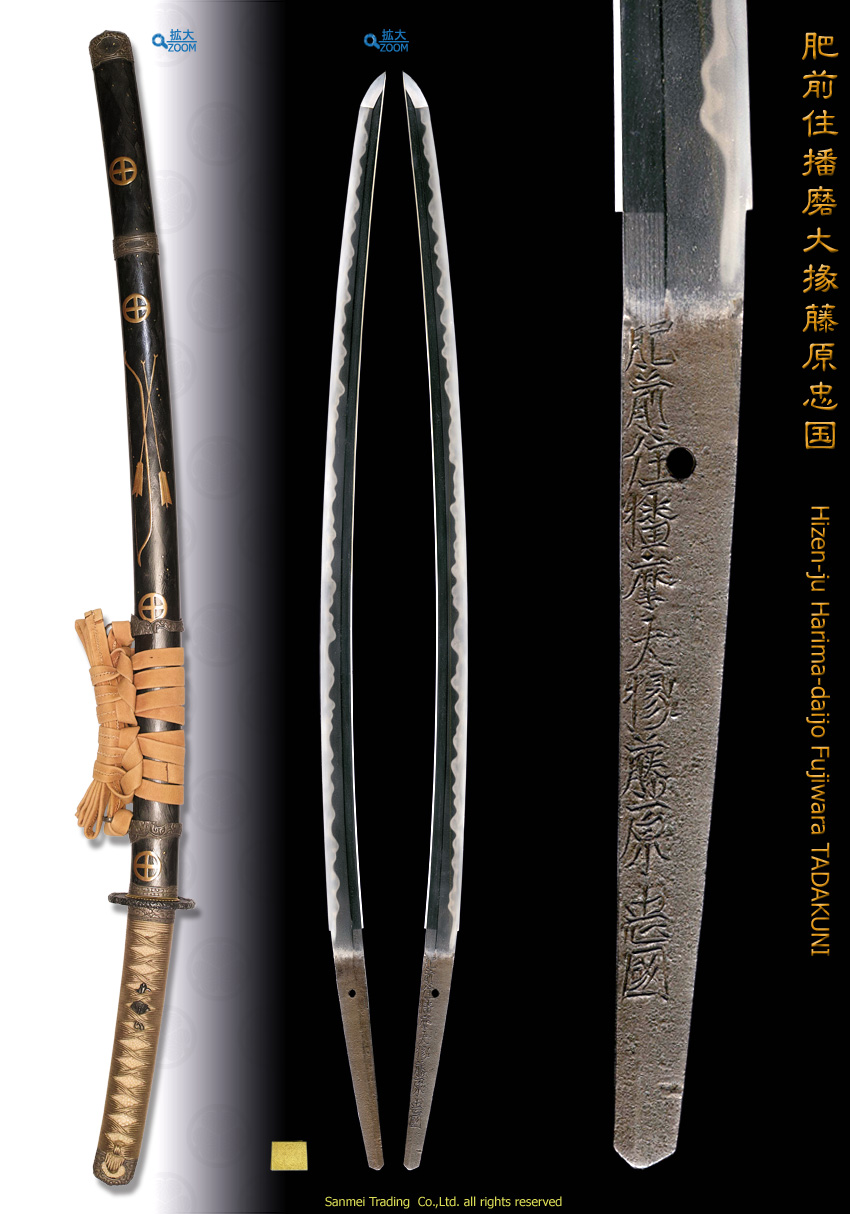with)Black lacquered brushing trace surface crest of Maru-ni-juji crest Handachi-style Koshirae mounting
Length of cutting edge71.1cm Curvature1.7cm Width of base28.6mm Thickness of base7.2mm Width of Yokote18.1mm
Forging(Hada): Forging is conspicuous Itame mixing with large Mokume-hada indication. Taste of fine steel gives off moistened impression by sparkling ji-nie glitter that generates rich and thick Nie lines of grain pattern so called CHIKEI activity.
Temper(Hamon): Hamon is fine Nie hard metal granules base, starting with straight Yakidashi shortly underneath habaki then flamboyant frequent Choji "clove outline" which varies in height and shape such as long footed, large clustered or cross over. The interior of temper is filled with mist-like crystallize area deeply with ASHI and floating YOU activities, thick lines of nie SUNAGASHI and bright curved threadlike KINSEN areas. Deep sparkling Nie accumulates on the gorges of Clove-outline and a pair of round head forms likely "eyes of horsefly" so called "Abunome". The entire temper is full of flamboyant impression.
Temper of tip(Boshi): Temper of boshi forms straight with frequent thick lines of Nie then medium circle turns back gently.
Tang(Nakago): Nakago is in UBU original. One peg hole. Greatly slanting left (O-sujikai) filemarks. Back ridge of Nakago is flat and V-shape (kengyo) heel of which summit is filed away in flat. The signature in the reversed side is eleven character that starts from the place of work Hizen-ju μOZ and an official district Harima-daijo dε title, name of clan Fujiwara ‘΄ and the smith name TADAKUNI .
The first generation TADAKUNI , real name Hashimoto Rokurozaemon ΄{ZYΆqε, was the second son of HIROSADA LεAreal name Hashimoto Souemon-no-jo ΄{EqεΡ who was younger brother by different mothers of 1st generation Hizen-koku TADAYOSHI μOg.TADAKUNI was born in keicho 9 (1604) and learned from his master, father HIROSADA Lε to name himself HIRONORI L₯. Among Hizen sword makers of head legitimate and 2 major branches, TADAKUNI is older than cousin MASAHIRO ³L by 3 years and 10 years older than 2nd gen. legitimate TADAHIRO L. Those top skilled sword makers in Hashimoto family sometimes had ghostmade/signed for their great master 1st gen. TADAYOSHI in his later ages.
The first generation TADAKUNI enjoyed an official district Harima-daijo dε title and changed smith name from HIRONORI L₯ to TADAKUNI @in Kanei 11 (1634) when he was 34 years old. He served exclusively to a feudal lord Nabeshima MOTOSHIGE η³Ξ in Ogi district Saga ¬ι. on after Shouho 1 (1644-) and had changed his style of sign that would come from a change in his state of mind. In his later ages Kanbun era (1661-), he gave the Harima-daijo dε title back and obtained the upgraded title of Harima-no-kami dη. Passed away in the 22nd day, 4th month, Genroku 4 (1691) was 88 years old.
The subject katana, distinguished from the style of signature, was made on about 1640 in decade, his earlier stage sooner ages after he enjoyed Harima-daijo title in 1634 but before he changed his signature style on about 1644. The style of filemark in these ages is remarkable greatly slanting left and angle of V-shape heel is steep slope with it's summit is filed off in flat. For those characters of tang would be intentionally made to discriminate the difference from the other Hizen swords or works of his son.
In compare with the other Hizen swords, the hamon is the most gaily decorated with vividly bright hard metal granules with rich activities of mist-like crystalline area, thick lines of nie, short lines of nie and bright curved threadlike areas. This is an example that among Hizen swords in Edo period, 1st gen. TDADKUNI's work is the most fascinatingly splendor in Clove hamon and well-balanced proportioned shape as well.
Black lacquered brushing trace surface crest of Maru-ni-juji crest Handachi-style Koshirae mounting consists of :
(click HERE for entire Koshirae / HERE for each fitting)
- Metal fittings of Kabuto-kane, Fuchi, Kuchi-kane, Ashi-kanamono, Seme-kanamono, Ishizuki-kanamono - Clouds design, silver ground Sukisage carving, unsigned
- Menuki a set of harness design, Shakudo Yobori style carving, gold/silver Iroe
- Tsuba of cloud design, Silver ground, leather wrinkles surface, Sukisage carving, unsigned
- Scabbard Brushing trace wave design with gold sprinkled lacquered surface gold Makie crests of Maru-ni-ju-ji in relief, bow and arrow design
- Hilt White rayskin, golden brown silk cord lozenge wrap
Skilled polish/Condition scale: excellent - mint-excellent (using a scale of mint-excellent-very good-good-fair-poor).
reference :
Yokoyama Manabu Hizento Bibouroku 2006
Token Bijutsu #665 2012
Kataoka Ginsaku Hizento Shiko 1974



